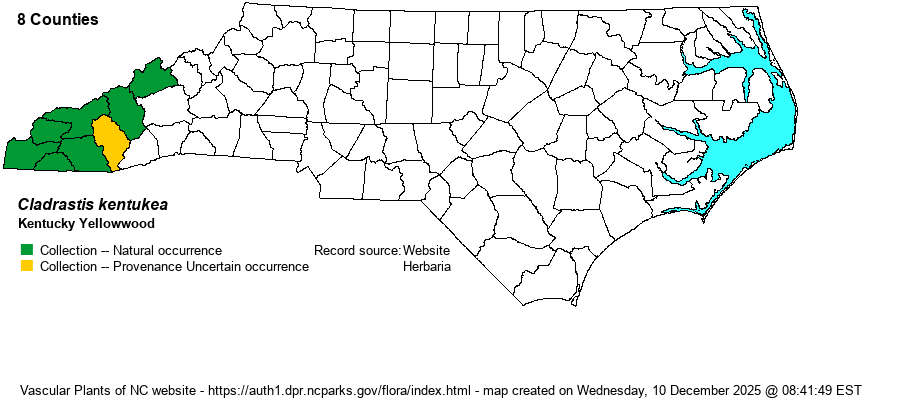| Author | (Dumont de Courset) Rudd | |
| Distribution | The native distribution is strictly limited to the southwestern Mountains, essentially well west of the Blue Ridge; mainly on ridges along or close to the TN or GA borders. Ranges north to Madison County. Occurrences in the Piedmont are of escaped individuals.
This is a Southern species, primarily of the southern Appalachians and Ozarks, with localized populations between these ranges. Occurs from southwestern NC westward to eastern OK, being most widespread in western AR and central TN. There are many out-of-range counties, but as this species often escapes or is planted, its true distribution is difficult to be certain. However, there is a native disjunction along the Savannah River bluffs close to the Fall Line in SC.
| |
| Abundance | Rare to locally uncommon; one of the least numerous native trees in the state. On the NC NHP Watch List; formerly on the Rare List. Widely planted elsewhere in the Mountains and in the Piedmont, and sometimes is found as a local escape. | |
| Habitat | This species grows strictly on rich, high pH soils of hardwood forests, including cove forests. It favors bluffs or steep slopes, but can grow on riverbanks. |
| Phenology | Blooms in April and May, generally as the leaves are unfurling. Fruits in July and August. | |
| Identification | This is a medium-sized deciduous tree, averaging about 50-55 feet in height. It should be easily identified by the large size of the quite widely elliptical (rounded) leaflets; the 7-9 leaflets average about 3 inches long and 2-2.5 inches wide. If that isn’t helpful, when in bloom the very long hanging racemes or panicles of white flowers easily attract attention. These inflorescences are often 8-10 inches long or longer. Sadly, the tree does not seem to grow in considerable numbers in a given area or on a given slope; it typically grows as scattered individuals or a small cluster of trees. Thus, it is not often seen by the public, as most of its locations are somewhat remote from well-traveled roads, far from major towns and cities. | |
| Taxonomic Comments | This species has usually been named as Cladrastis lutea (e.g., RAB 1968), until recently.
| |
| Other Common Name(s) | Often simply called “Yellowwood” or “Yellow-wood”, but as there are several species of Cladrastis in Asia, most references prefer to use a modifier. American Yellowwood is often used.
| |
| State Rank | S2S3 | |
| Global Rank | G4 | |
| State Status | W1 | |
| US Status | | |
| USACE-agcp | | |
| USACE-emp | | |

